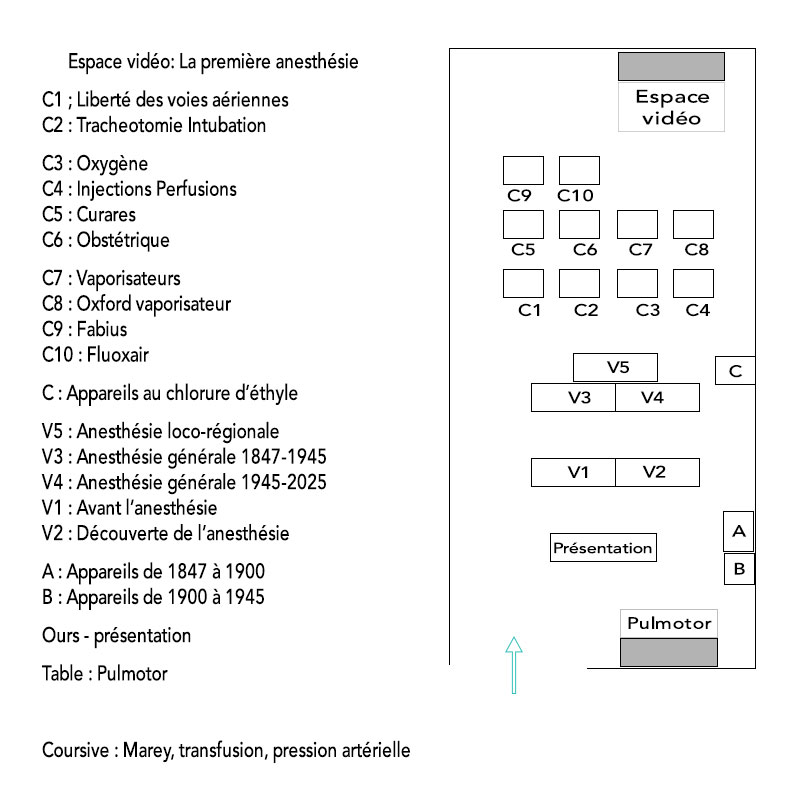The use of medication or procedures for reducing pain goes back to earliest antiquity.
Inhalation of vegetable substances
The use of cannabis goes back more than 5000 years BC. Indian hemp featured in The dried herb book of the divine cultivator (Sheng – Nung, China 2700 BC). Numerous plants including poppy, hemlock, mandrake, henbane, and datura were known in ancient times and were used sometimes in surgery.
The sponge has been used since mediaeval times for delivery by inhalation. The very first trace of its use in the Western World is to be found in the lXth century in the Benedictine monasteries (Monte Cassino in Italy and Bamberg in Germany). This technique was repeated with several variations during the succeeding centuries, starting in Salerno in the XIth century and then in Bologna, Montpellier and Avignon. In 1471, a new edition of the Book of Nicolaus Salernitanus dating from the XIth century (shown here) gave a recipe for the use of mandrake with other plants to induce sleep and analgesia.
The idea was to prepare a mixture of plants, soak them onto a sponge which was then dried and stored in a closed vase. The sponge was then dampened with hot water before use and the patient inhaled the vapours before surgery. Each convent had its own recipe which could not be used elsewhere since it depended on the quality of the plants used.
Alchemy
Volatile substances were made by alchemists during the Middle Ages with ether and chloroform discovered after the XIIth century. In the XVIth century Paracelsus (1493 – 1541) prepared ether from sulphuric acid and alcohol and described its analgesic and anaesthetic properties as well as total reversibility of the effects. But there was no apparent application.
At the end of the XVIth century, the great alchemist Della Porta (1535 – 1615) succeeded in linking the properties of alcohol and vegetable distillates. He did not use a sponge but fashioned ‘apples’ (a form of inhaler) which then caused loss of sensation and immobility.
Blood vessel or nerve compression
The Assyrians (2000 – 800 BC) caused unconsciousness by compression of the carotid blood vessels before circumcision. Ambroise Paré compressed blood vessels to reduce blood loss during amputations (1564). The same procedure was used by Jean-Louis Petit (1718). In 1784, James Carrick Moore advocated nerve compression to produce analgesia during amputations.
Alcohol and regional hypothermia
It was well–known that during acute drunkenness a certain degree of analgesia could be achieved as shown in a XVth century engraving. In 1646 Marco Aurelio Severino in Italy recommended cold mixtures of ice and snow for surgical anaesthesia. At the battle of Eylau (1807) and during the Russian campaign, Dominique Larrey observed the beneficial effects of cold during surgery.
Hypnotism
Modern use of hypnotism was started by Franz Anton Mesmer (1733 – 1815). He created a hypnotic method in 1780 which he named animal magnetism. We recall the first users of hypnotism: Puységur 1815, Cloquet 1829, Esdaille 1840, Braid 1842 and Hippolyte Bernheim 1884.
Missed opportunities in inhalation anaesthesia
In 1800 Humphry Davy suggested the used of nitrous oxide for non – haemorrhagic surgical operations.
We recall the sad history of Henry Hill Hickman who, in France in 1824 as in England did not succeed in interesting the medical world in the anaesthetic effects of carbon dioxide and of ‘certain other gases.’








